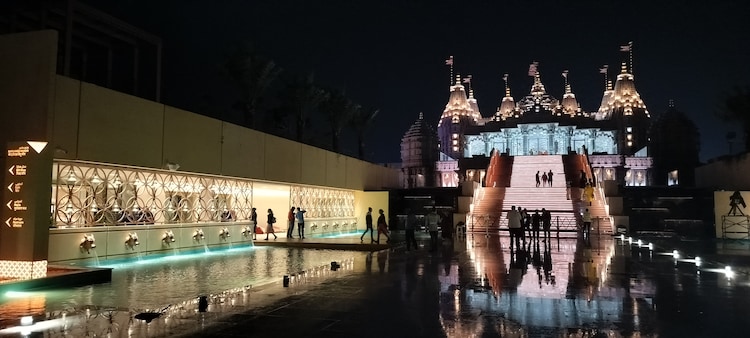
BAPS Mandir: Abu Dhabi's first Hindu temple to be inaugurated by PM Modi on Feb 14
Constructed on a 27-acre plot, the soon-to-be-inaugurated BAPS Swaminarayan Mandir in Abu Dhabi is a stunning architectural marvel. The temple's foundation was laid in 2019. Read more about the features of the grand structure.

The sprawling BAPS Swaminarayan Mandir in Abu Dhabi, the city's first Hindu temple, is set to be inaugurated by Prime Minister Narendra Modi on February 14 (Wednesday), during his visit to the UAE. The temple will open to the public on March 1.
Constructed on a 27-acre plot, the temple is a stunning architectural marvel that holds a prayer hall having a capacity of 3,000 people, a community centre, an exhibition hall and several other attributes.
ARCHITECTURE
The temple, whose foundation stone-laying ceremony took place in April 2019, reflects the unparalleled grandeur of the traditional Nagar style of architecture.
Built with 1.80 lakh cubic feet of pink Rajasthan sandstone, 50,000 cubic feet of pristine white Italian marble and 18 lakh bricks, the temple stands tall at 108 feet, being crowned with seven shikhars (spires) each representing one of the seven emirates of the UAE.
Surrounding the temple are meticulously crafted ghats and features of the holy rivers Ganga and Yamuna. The temple has two central domes -- ‘Dome of Harmony’ and ‘Dome of Peace’.
The entrance of the temple is marked by eight murtis (idols), symbolising the eight values foundational to Sanatana Dharma. The temple space is an ode to human harmony and coexistence with nature, meticulously depicted through the carvings of earth, water, fire, air, and plant life on a dome.
The diverse heritage of humanity finds pride in its place within these sacred spaces. Stories from ancient civilisations -- Maya, Aztec, Egyptian, Arabic, European, Chinese and African -- are all captured in stone, a testament to the interconnected essence of global spirituality while honouring India's rich spiritual heritage.
CULTURAL HUB
The temple complex, spread over 13.5 acres, is not just a place of worship but also a cultural hub, complete with a visitors' centre, exhibitions, prayer halls, learning areas, sports facilities for children and young people, a food court, thematic gardens, a book and gift shop, and various other amenities.
SHRINES OF DIFFERENT DEITIES
The temple houses seven shrines, each dedicated to different deities hailing from the North, East, West and South parts of India. These deities include Lord Ram and his wife Sita; Lord Hanuman; Lord Shiva and his wife Parvati and children Ganesh and Karthik; Lord Jagannath; Lord Krishna and his wife Radha; Shri Akshar-Purushottam Maharaj; Lord Tirupati Balaji and Lord Ayyappa. Each shrine is adorned with exquisite carvings reflecting the life and teachings of their respective deities.
In the shrine dedicated to Lord Shiva, the splendid carvings depict the vibrant verses of 'Shiv Puran' and illustrate the domains of the 12 'Jyotirlings'. The celebration of 'Jagannath Yatra' or 'Rathyatra' is skillfully carved within the shrine of Lord Jagannath. Stories from 'Bhagwat' and 'Mahabharat' come alive inside the sanctum dedicated to Lord Krishna.
On the other hand, Swaminarayan and Lord Ayyappa’s life, work, and teachings are captured meticulously in stone within their respective shrines.
Visitors to the shrine of Lord Ram can find themselves immersed in the magnificent tales of 'Ramayan' intricately adorned on the temple walls. The sacred 'Plinth of Values' and depictions of holy rivers serve as a testament to the potent spiritual and ethical foundation of Indian culture.
Modern and minimalistic architectural aesthetics effortlessly blend with timeless spiritual iconography in these shrine complexes. Surrounded by monolithic structures, the temples house an astounding 402 pillars, meticulously carved from 25,000 stone pieces.
ECO-FRIENDLY STRUCTURE
In line with sustainable practices, the temple construction has incorporated fly ash to replace a significant portion of cement in the concrete mix, thereby reducing its carbon footprint. Additionally, around 150 sensors monitor the structure's temperature, pressure, stress and seismic events, ensuring the safety and longevity of the temple.
No ferrous material has been used, maintaining the purity of the religious space. To keep the sacred space welcoming in all weather conditions, nano tiles have been installed with designs to keep visitors comfortable even in extreme heat.
Open to people of all faiths, the temple invites visitors to explore and learn about Hindu culture and spirituality.
ACCOLADES
The BAPS Hindu Mandir is not only an architectural marvel but also a beacon of spiritual enlightenment and social service, managed by the global community-based and volunteer-driven Bochasanwasi Akshar Purushottam Swaminarayan Sanstha (BAPS).
The temple has already won several accolades, including the Best Mechanical Project of the Year 2019, at the MEP Middle East Awards, Best Interior Design Concept of the Year 2020, Best Architecture Style and Best Traditional Nagar Style.






